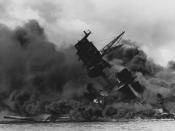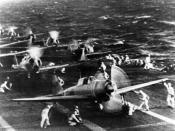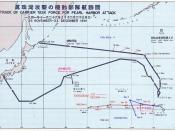IntroductionOn the morning of December 7, 1941, the Empire of Japan's Carrier Striking Task Force made a surprise attack on the United States naval base on Pearl Harbor, Oahu, Hawaii (which is situated in the North Pacific Ocean, 2,300 miles (3,700 km) from the mainland of the United States.), against the U.S. Pacific Fleet and other US armed forces stationed at the harbor and also on the other side of Oahu. The attack encourage the U.S. into entering World War II on the following day and officially started the Pacific War.
There are many reasons behind the attack on Pearl Harbor, here are some major reasons why:ÃÂJapan wanted to build a strong empire in AsiaÃÂJapan had appointed a war-like general as Prime MinisterÃÂJapan believed the Americans would not fight backÃÂJapan believed a war with America was inevitable anyway and wished to strike firstÃÂJapan was already at war with ChinaÃÂAmerica provoked Japan into war by imposing trade sanctions and making impossible demandsÃÂJapan needed raw materials like oil.
It could only get them by invading oilfields in South-East Asia.
During the year 1941, there was already a plan to attack Pearl Harbor. Through out the year, the Japanese military was used in planning, training, weapon development, spying, and organization with other plans to invade East Asia. In September 1941, the Japanese believed a war with America was predictable, unless the U.S. agreed with the Japanese positions in China, Indochina, and elsewhere. Preparations for attacks against Malaya, the Philippines, and separated Pacific islands were ready by the planned date of early December. Pearl Harbor attack planning was a part of the Japanese probability the U.S. would be unavoidably drawn into the war after a Japanese attack against Malaya and Singapore.
Neutralizing the American naval power in the Pacific was the aim of surprise attack on Pearl Harbor, if only for the time being. The Japanese had two options either attack the U.S. or giving up their territory in South-east Asia. The success of this attack was the only way to keep the future of Imperial Japan. The difficulties of this attack would be very hard to be succeed by two reasons. First, the Pacific Fleet was a remarkable force, and would not be easy to defeat or surprise. Second, for air attack, Pearl Harbor's shallow waters made using traditional air-dropped torpedoes ineffective. On the other hand, Hawaii's isolation meant a successful surprise attack could not be blocked or quickly countered by forces from the U.S.
Reasons behind the attack on Pearl HarborBy 1900 Japan was on its way to becoming a major power. It was rapidly building up its industry. It was a major trading nation, but depended on imports of raw material. To gain raw materials of its own it began to think about invading Manchuria (part of china). Manchuria had plenty of coal and iron and the people there would provide a market for Japanese goods. However, for the time being Japan simply increased its trade links with Manchuria. In 1905 Japan won a war with Russia. As a result it gained control of Korea. It also sent soldiers to Manchuria to protect its business interests there.
After the 19th century, which replaced the previous government among other wide-sweeping effects, the Empire of Japan got on a fast economic, political, and military development to reach equality with the European and North American countries in terms of power. Part of this strategy included extending territorial and economic control to increase access to populations, bases, and natural resources which were thought needed because of a lack of rich resource in the Japanese home islands. That rapid industrialization demanded more resources than were available. In order to match up Western powers, Japan quickly developed its military and economy under the slogan "National Wealth and Military Strength." Military personnel played an increasing role in policy and then in government, especially after the early years of the 20th century. Eventually, Generals Hideki Tojo and Kuniaki Koiso became Prime Ministers. From about 1910 through the 1930s, Japan became significantly militarized, in particular building a big and modern navy, the third largest in the world at the time. In 1931, without telling the Japanese government what it was going to do, the army acted. Japanese troops seized the whole of Manchuria. As an excuse, they said that Chinese troops had disrupted the Southern Manchurian Railway, which Japan controlled. This success in Manchuria meant that more Japanese people supported the idea of expanding into new territories. The newspapers began to praise the army, and demand that Japan should become the dominant power in the East. By 1932 the government was doing what ever the army wanted. The amount of money spent on the armed forces rose very rapidly. In 193 the army had 250,000 men, in 1936 it had 400,000 and in 1937 it had 950,000. The USA was now very concerned about events in East Asia. Its worries increased in 1936 when Japan signed a pact with Germany. Then, in 1937, Japan invaded China, and in 1941 it invaded Indo-China.
In 1941, with the agreement of Vichy France (French government), Japan moved into northern Indochina. The U.S. responded by freezing Japan's properties in the U.S., and beginning a complete oil ban. Oil was Japan's most crucial lack in resources; her own supplies were very limited. 80+% of Japan's imports came from the U.S. and the Imperial Navy relied entirely on imported oil stocks. To secure its oil supplies, and other resources, Japanese planners had long been looking to the South, especially the Dutch East Indies. The Navy was sure any attempt to take control of this region would bring the U.S. into the war, but with the oil ban, determination to take control of the necessary resources increased. Planning (espionage, logistics, etc) continued.
Should the Japan have attacked Pearl Harbor or notLate in November, all Pacific commands, including both the Navy and Army in Hawaii, were one by one and clearly warned war with Japan was expected in the very near future, probably with attacks in the Far East: the Philippines, Vietnam, or Russia. The warnings were not specific to any area, noting only that war with Japan was to be expected in the immediate short term and that all commands should act accordingly. Had any of these warnings produced an active alert status in Hawaii, the attack would likely have been fought back more effectively, and perhaps might have caused less death and damage. On the other hand, recall of men on shore leave to the ships in harbor might have led to still more being casualties from bombs and torpedoes, or trapped in ships by shut watertight doors (as the attack alert status have required).
When the attack actually arrived, Pearl Harbor was effectively unprepared: anti-aircraft weapons was not operating, most ammunition locked down, anti-submarine measures not applied (e.g., no torpedo nets in the Harbor), combat air patrol not flying, available scouting aircraft not in the air at first light, Air Corps aircraft parked wingtip to wingtip to reduce damage risks not to be ready to fly at first warning, and so on.
The attack on Pearl Harbor failed to destroy the three aircraft carriers assigned to the Pacific Fleet (Enterprise, Lexington, and Saratoga). The attack did result in the permanent loss of Arizona and Oklahoma, and it removed several other battleships from the order of battle (including Nevada, West Virginia, and California). However, all of these were older designs, requiring repair before working as part of the carrier task forces which became central to the Pacific War. Probably more important in the short run was the damage of over 155 aircraft, damage to the main forward naval base in the Pacific, and to American pride.
Genda's plan, and Nagumo's execution, left the transportation of the Pearl Harbor base and the Navy Yard, except the battleships, almost untouched. Cruisers, essential to carrier task forces later in the War, suffered little damage, and only three destroyers were lost: Shaw, Cassin, and Downes. (Even so machinery from both of the latter, and even the Arizona, were successfully recovered.) The tank farms, containing 530 million liters of fuel oil, were untouched. The Navy Yard, critical to ship repairs, famously to Yorktown prior to Midway, was undamaged. The engineering and repair shops were in one piece. The torpedo store was, as well. The power station, central to base function, continued to operate. The Submarine Base, critical to the initial phase of the War and to trade raiding throughout, was unaffected.
Japan was temporarily free of worries about the rival Pacific naval power, which was at least part of what had been intended by the Pearl Harbor attack. She conquered Southeast Asia, the Southwest Pacific, and extended her reach far into the Indian Ocean, albeit without occupying territory.
However, in the end, the attack was a strategic disaster. It encouraged the United States into a strength of mind to fight to complete victory. It resulted in the destruction of the Japanese armed forces, the Occupation of the home islands, and even the loss of territory (the Kuriles) which has not been returned even six decades later.
What actually happened at Pearl Harbor.
ConclusionThere are many reasons that motivated the Japanese to attack Pearl Harbor. These reasons are economic, political, and militaristic in nature. However, it is easy to forget that the main reason for the attack on Pearl Harbor was the United StatesÃÂ belief that it should be the only power capable of controlling the Pacific region. This led the United States to impose an oil embargo on Japan the forced the Japanese to expand their empire to include oil fields in Southeast Asia. The only way Japan could do this was to destroy the American pacific fleet, giving them enough time to conquer the land that they wanted, at the same time, stop negotiation with the US as they would not have any bargaining chips on their hands if the Pacific fleet was destroyed. This meant that an attack on Pearl Harbor would be necessary.
Bibliographyhttp://wiki.answers.com/Q/Why_did_the_Japanese_attack_Pearl_Harborhttp://suzyred.com/2002pearlharbor.htmlhttp://en.wikipedia.org/wiki/Attack_on_Pearl_Harborhttp://www.u-s-history.com/pages/h1649.htmlhttp://www.apfn.org/apfn/pearl_harbor.htmhttp://www.worldwar2history.info/Pearl-Harbor/


